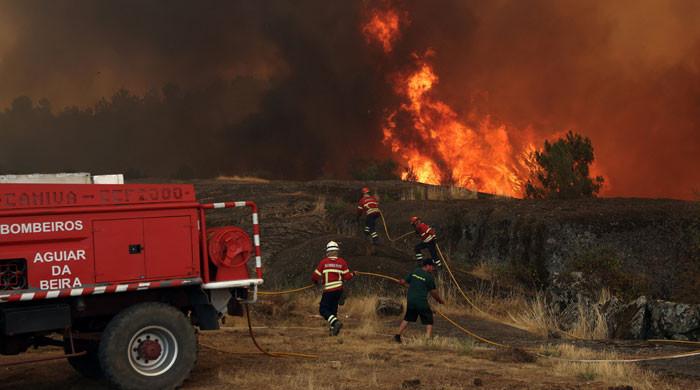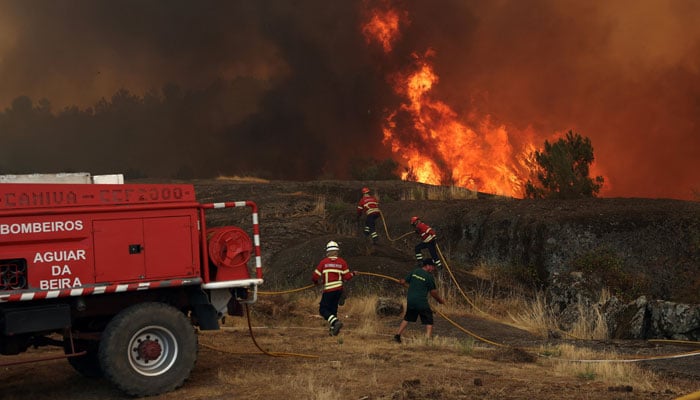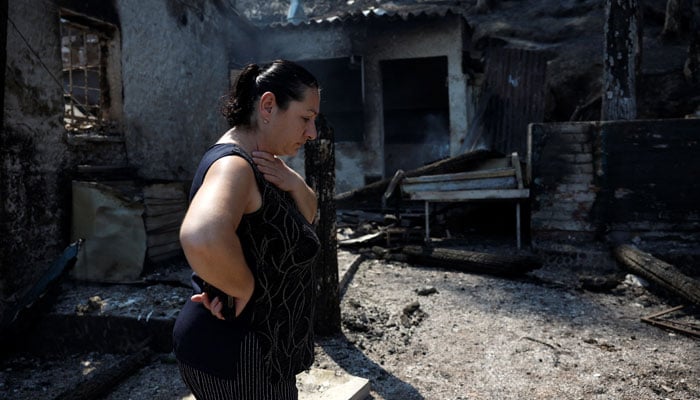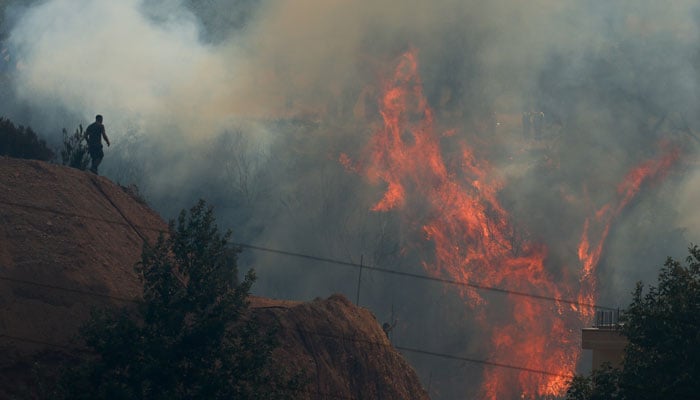Business
Wildfires fanned by heatwave, strong winds rage across Europe


- About 7,700 people evacuated near Greek city of Patras.
- Volunteer firefighter died and several hospitalised in Spain.
- Pope Leo moves weekly St Peter’s Square indoors amid heat.
Wildfires caused by arsonists or thunderstorms and fanned by a heatwave and strong winds continued to rage across southern Europe on Wednesday, burning houses, farms and factories and forcing the evacuation of thousands of residents and tourists.
Flames and dark smoke billowed over a cement factory that was set alight by a wildfire that swept through olive groves and forests and disrupted rail traffic on the outskirts of the Greek city of Patras, in the northern Peloponnese west of Athens.
“What does it look like? It looks like doomsday. May God help us and help the people here,” said Giorgos Karvanis, a volunteer who had come from Athens to Patras to help.
Authorities ordered residents of a town of about 7,700 people near Patras to evacuate on Tuesday and issued new alerts on Wednesday, advising residents of two nearby villages to leave their homes.
On the Greek islands of Chios, in the east, and Cephalonia, in the west, both popular with tourists, authorities told people to move to safety as fires spread.
In Spain, a volunteer firefighter died from severe burns and several people were hospitalised as the state weather agency AEMET warned that almost all of the country was at extreme or very high risk of fire.
The 35-year-old man had been attempting to create firebreaks near the town of Nogarejas, in the central Castile and Leon region, when he was trapped in the blaze, regional officials said.
He was the sixth person to die this year in wildfires in Spain. Other victims include two firefighters in Tarragona and Avila, according to emergency services.

Working in unprepared landscapes puts firefighters’ lives at risk, said Alexander Held, a senior expert in fire management at the European Forest Institute.
Authorities needed to make more effort to anticipate and prevent wildfires by creating buffer zones and clearing combustible vegetation, he said.
“Take an industrial building and imagine there would be no fire detectors, no sprinkler systems, no fire protection doors and no escape routes – firefighters would just refuse to go in, but in our landscape we expect them to do this,” said Held.
The leader of the Galicia region in the northwest, Alfonso Rueda, called the situation there “complicated” and said the weather was not helping. Six active fires were affecting a combined 10,000 hectares (38 square miles) in Galicia’s Ourense province.
Suspected arson
Spanish Environment Minister Sara Aagesen told SER radio station that many fires across the country were suspected to be intentionally caused by arsonists due to their “virulence”.
A male firefighter was arrested on Tuesday for fires started in the Avila area north of Madrid two weeks ago, while police said late on Tuesday they were investigating a 63-year-old woman for allegedly starting a series of fires in Galicia’s Muxia area in August.

Police have also identified a suspect who is believed to have suffered burns to his hands after starting a small fire in a beachfront development in the southern coastal Cadiz area, Europa Press reported.
Thunderstorms have caused other fires.
On Tuesday, shortly after 5pm, Andalucia’s fire department was flooded with calls from residents alerting of a fire caused by a lightning strike on a chestnut and oak forest in Los Romeros, north of the city of Huelva. The fire prompted the evacuation of around 250 residents but was largely controlled by Wednesday morning.
A blaze in Trancoso in Portugal that has been burning since Saturday took a turn for the worse during the night as a lightning strike reignited an area that was thought safe, the civil protection service said.
In Albania, Defence Minister Pirro Vengu said it was a “critical week”, with several major wildfires burning across the country.

Some 10,000 firefighters, soldiers and police emergency units struggled with a total of 24 wildfires across the country on Wednesday, the defence ministry said.
Flames reached homes in two villages in the centre of the country, forcing villagers to flee, taking their livestock with them.
“We are going in the middle of two rivers because the fire has arrived,” said Hajri Dragoti, 68, from Narte, who fled with his wife, taking a cow, a donkey and a dog. “We can’t do anything; it is like gunpowder.”
Spain was in its 10th day of a heatwave that peaked on Tuesday with temperatures as high as 45 degrees Celsius (113 degrees Fahrenheit), and which AEMET expected to last until Monday, making it one of the longest on record.
Pope Leo moved his weekly audience from St Peter’s Square to an indoor venue in the Vatican, “to stay a little bit out of the sun and the extreme heat” as Italy’s health ministry issued extreme heat warnings for 16 cities on Wednesday, with temperatures forecast to peak at 39°C (102°F) in Florence.
Business
Gross GST collections for November stand at over Rs 1.70 lakh crore; up 0.7 per cent – The Times of India

GST collections: The Gross Goods and Services Tax (GST) collections for the month of November came in at over Rs 1.70 lakh crore. This is a rise of 0.7%, according to official data.SBI Research in a report in November had estimated that the gross domestic GST collections may come around Rs 1.49 lakh crore for November 25 (returns of October 25 but filed in Nov’25), a YoY growth of 6.8%.“Coupled with Rs 51,000 crore of IGST and cess on Import, the November GST collections thus could cross Rs 2.0 lakh crore, driven by the peak festive season demand led by lower GST rate and increased compliance while most of states experience positive gains,” SBI Research had said.This story is being updated
Business
Key Financial Deadlines That Have Been Extended For December 2025; Know The Last Date

New Delhi: Several crucial deadlines have been extended in December 2025, including ITR for tax audit cases, ITR filing and PAN and Aadhaar linking. These deadlines will be crucial in ensuring that your financial affairs operate smoothly in the months ahead.
Here is a quick rundown of the important deadlines for December to help you stay compliant and avoid last-minute hassles.
ITR deadline for tax audit cases
The Central Board of Direct Taxes has extended the due date of furnishing of return of income under sub-Section (1) of Section 139 of the Act for the Assessment Year 2025-26 which is October 31, 2025 in the case of assessees referred in clause (a) of Explanation 2 to sub-Section (1) of Section 139 of the Act, to December 10, 2025.
Belated ITR filing deadline
A belated ITR filing happens when an ITR is submitted after the original due date which is permitted by Section 139(4) of the Income Tax Act. Filing a belated return helps you meet your tax obligations, but it involves penalties. You can only file a belated return for FY 2024–25 until December 31, 2025. However, there will be a late fee and interest charged.
PAN and Aadhaar linking deadline
The Income Tax Department has extended the deadline to link their PAN with Aadhaar card to December 31, 2025 for anyone who acquired their PAN using an Aadhaar enrolment ID before October 1, 2024. If you miss this deadline your PAN will become inoperative which will have an impact on your banking transactions, income tax return filing and other financial investments.
Business
Stock Market Live Updates: Sensex, Nifty Hit Record Highs; Bank Nifty Climbs 60,000 For The First Time

Stock Market News Live Updates: Indian equity benchmarks opened with a strong gap-up on Monday, December 1, touching fresh record highs, buoyed by a sharp acceleration in Q2FY26 GDP growth to a six-quarter peak of 8.2%. Positive cues from Asian markets further lifted investor sentiment.
The BSE Sensex was trading at 85,994, up 288 points or 0.34%, after touching an all-time high of 86,159 in early deals. The Nifty 50 stood at 26,290, higher by 87 points or 0.33%, after scaling a record intraday high of 26,325.8.
Broader markets also saw gains, with the Midcap index rising 0.27% and the Smallcap index advancing 0.52%.
On the sectoral front, the Nifty Bank hit a historic milestone by crossing the 60,000 mark for the first time, gaining 0.4% to touch a fresh peak of 60,114.05.
Meanwhile, the Metal and PSU Bank indices climbed 0.8% each in early trade.
Global cues
Asia-Pacific markets were mostly lower on Monday as traders assessed fresh Chinese manufacturing data and increasingly priced in the likelihood of a US Federal Reserve rate cut later this month.
According to the CME FedWatch Tool, markets are now assigning an 87.4 per cent probability to a rate cut at the Fed’s December 10 meeting.
China’s factory activity unexpectedly slipped back into contraction in November, with the RatingDog China General Manufacturing PMI by S&P Global easing to 49.9, below expectations of 50.5, as weak domestic demand persisted.
Japan’s Nikkei 225 slipped 1.6 per cent, while the broader Topix declined 0.86 per cent. In South Korea, the Kospi dropped 0.30 per cent and Australia’s S&P/ASX 200 was down 0.31 per cent.
US stock futures were steady in early Asian trade after a positive week on Wall Street. On Friday, in a shortened post-Thanksgiving session, the Nasdaq Composite climbed 0.65 per cent to 23,365.69, its fifth consecutive day of gains.
The S&P 500 rose 0.54 per cent to 6,849.09, while the Dow Jones Industrial Average added 289.30 points, or 0.61 per cent, to close at 47,716.42.
-

 Sports1 week ago
Sports1 week agoWATCH: Ronaldo scores spectacular bicycle kick
-

 Entertainment1 week ago
Entertainment1 week agoWelcome to Derry’ episode 5 delivers shocking twist
-

 Politics1 week ago
Politics1 week agoWashington and Kyiv Stress Any Peace Deal Must Fully Respect Ukraine’s Sovereignty
-

 Business1 week ago
Business1 week agoKey economic data and trends that will shape Rachel Reeves’ Budget
-

 Tech6 days ago
Tech6 days agoWake Up—the Best Black Friday Mattress Sales Are Here
-

 Politics1 week ago
Politics1 week ago53,000 Sikhs vote in Ottawa Khalistan Referendum amid Carney-Modi trade talks scrutiny
-

 Fashion1 week ago
Fashion1 week agoCanada’s Lululemon unveils team Canada kit for Milano Cortina 2026
-

 Tech6 days ago
Tech6 days agoThe Alienware Aurora Gaming Desktop Punches Above Its Weight





